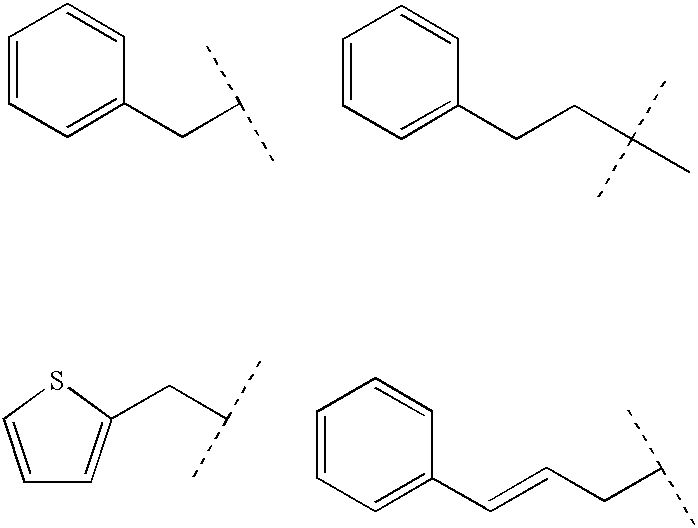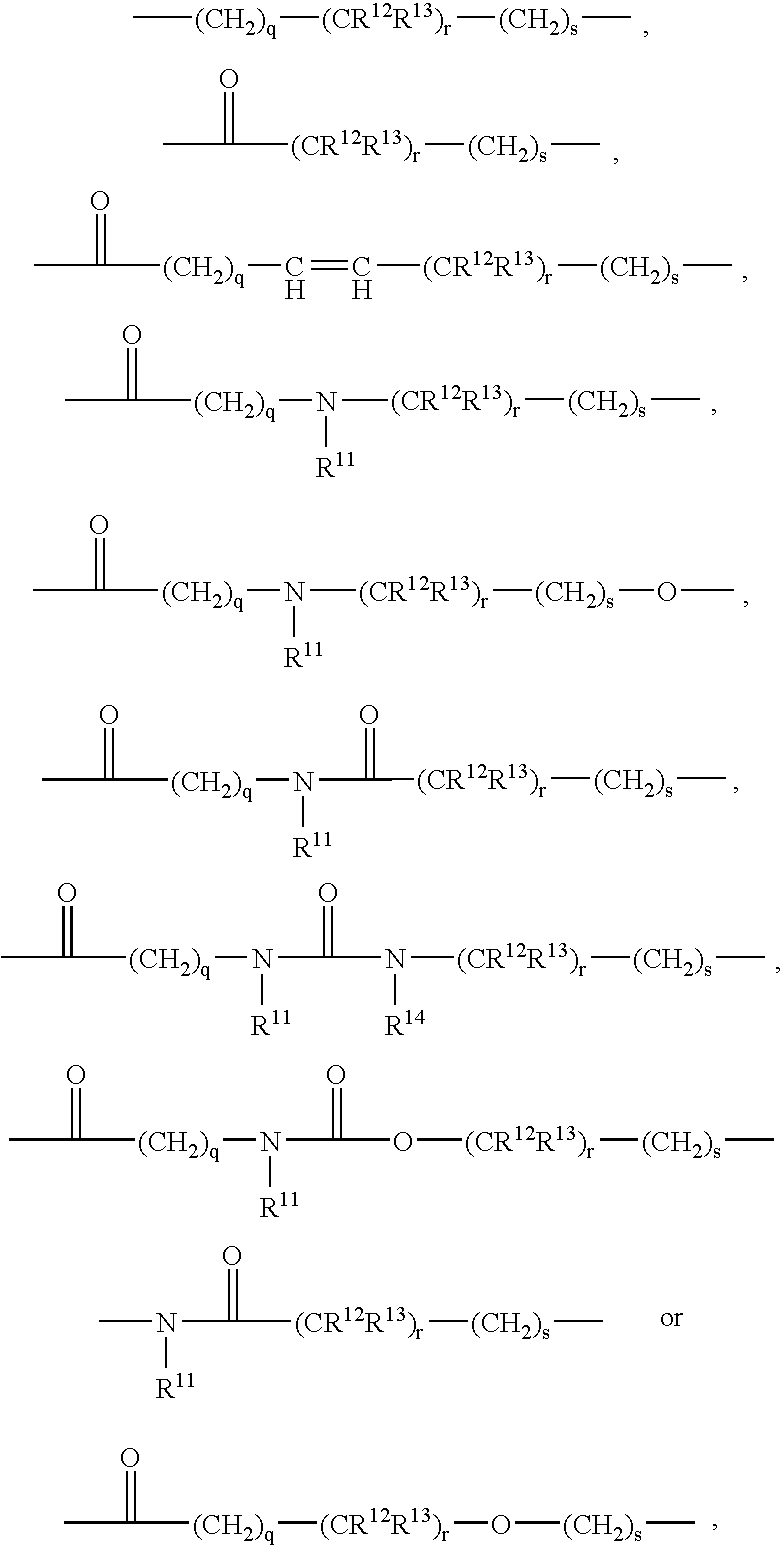Glucagon antagonists/inverse agonists
a technology of glucagon antagonists and inverse agonists, which is applied in the direction of urea derivative preparations, ester active ingredients, medical preparations, etc., can solve the problem of not being generally known orally availabl
- Summary
- Abstract
- Description
- Claims
- Application Information
AI Technical Summary
Problems solved by technology
Method used
Image
Examples
example 1 (
General procedure (A))
(R)-3-{4-[1-(4-Cyclohexylphenyl)-3-(3methoxy-5-trifluoromethylphenyl)ureidomethyl]benzoylamino}-2-hydroxypropionic acid
[0401]
Step 1: 4-((4-Cyclohexylphenylamino)methyl)benzoic acid methyl ester
[0402]4-Formylbenzoic acid methyl ester (6.65 g, 40.5 mmol) was dissolved in hot methanol (175 mL). To this mixture, 4-cyclohexylaniline (7.1 g, 40.5 mmol) was added. To the resulting suspension, more methanol (75 mL) was added and the mixture was heated at reflux for 1 hour. After cooling to 0° C., the mixture was filtered and the solid was washed with ice-cold methanol and dried in vacuo at 40° C. for 16 hours to afford 10.95 g of 4-[(4-cyclohexylphenylimino)-methyl]benzoic acid methyl ester. This compound (10.93 g, 34 mmol) was suspended in methanol (200 mL) and glacial acetate acid (27 mL) was added followed by sodium cyano borohydride (1.9 g, 30 mmol) in small portions. The mixture was stirred at room temperature for 1 hour and concentrated in vacuo. The residue was ...
example 2 (
General Procedure (A))
(R)-3-{4-[3-(3,5-Bis(trifluoromethyl)phenyl)-1-(4-cyclohexylphenyl)ureidomethyl]benzoylamino}-2-hydroxypropionic acid
[0416]
Step 2: 4-[3-(3,5-Bis(trifluoromethyl)phenyl)-1-(4-cyclohexylphenyl)ureidomethyl]benzoic acid method ester
[0417]4-((4-Cyclohexylphenylamino)methyl)benzoic acid methyl ester (2.38 g, 7.36 mmol) was dissolved in DCM (150 mL) and 3,5-bis(trifluoromethyl)phenyl isocyanate (1.36 mL, 8.10 mmol) was added and the mixture was stirred at room temperature for 16 hours. The reaction mixture was washed with water (3×15 mL), dried (magnesium sulphate) and concentrated in vacuo to afford 4.3 g of 4-[3-(3,5-bis(trifluoromethyl)phenyl)-1-(4-cyclohexylphenyl)ureidomethyl]benzoic acid methyl ester.
[0418]1H-NMR (DMSO-d6): δ 1.17-1.44 (m, 5H), 1.66-1.82 (m, 5H), 3.83 (s, 3H), 4.98 (s, 2H, 7.20-7.28 (m, 4H), 7.44 (d, 2H), 7.62 (s, 1H), 7.93 (d, 2H), 8.24 (s, 2H), 8.94 (s, 1H); HPLC-MS (Method A): m / z=579 (M+1); Rt=9.05 min.
Step 2a: 4-[3-(3,5-Bis(trifluoromethyl...
example 3 (
General Procedure (A))
(R)-3-{4-[3-(3-Bromophenyl)-1-(4-cyclohexylphenyl)ureidomethyl]benzoylamino}-2-hydroxypropionic acid
[0426]
Step 1: 4-[(4-Cyclohexylphenylamino)methyl]benzoic acid
[0427]4-Cyclohexylaniline (8.0 g, 53 mmol) was dissolved in methanol (200 mL) and a suspension of 4-formylbenzoic acid (9.4 g, 53 mmol) in glacial acetic acid (12 mL) was added in portions and the resulting mixture was heated at reflux temperature for 1.5 hour. After cooling to room temperature a mixture of sodium cyano borohydride (5.0 g, 80 mmol) in methanol (100 mL) was added in portions, and the resulting mixture was stirred at room temperature for 16 hours. The mixture was filtered and washed thoroughly with water and dried in vacuo at 50° C. for 3 days to afford 12.8 g (78%) of 4-[(4-cyclohexylphenylamino)methyl]benzoic acid.
[0428]1H-NMR (DMSO-d6): δ 1.1-1.35 (5H, m), 1.65-1.75 (5H, m), 2.29 (1H, m), 4.31 (2H, s), 6.15 (1H, bs), 6.45 (2H, d), 6.89 (2H, d), 7.46 (2H, d), 7.88 (2H, d).
Step 2: 4-[3-(...
PUM
| Property | Measurement | Unit |
|---|---|---|
| Molar density | aaaaa | aaaaa |
| Molar density | aaaaa | aaaaa |
| Molar density | aaaaa | aaaaa |
Abstract
Description
Claims
Application Information
 Login to View More
Login to View More - R&D
- Intellectual Property
- Life Sciences
- Materials
- Tech Scout
- Unparalleled Data Quality
- Higher Quality Content
- 60% Fewer Hallucinations
Browse by: Latest US Patents, China's latest patents, Technical Efficacy Thesaurus, Application Domain, Technology Topic, Popular Technical Reports.
© 2025 PatSnap. All rights reserved.Legal|Privacy policy|Modern Slavery Act Transparency Statement|Sitemap|About US| Contact US: help@patsnap.com



